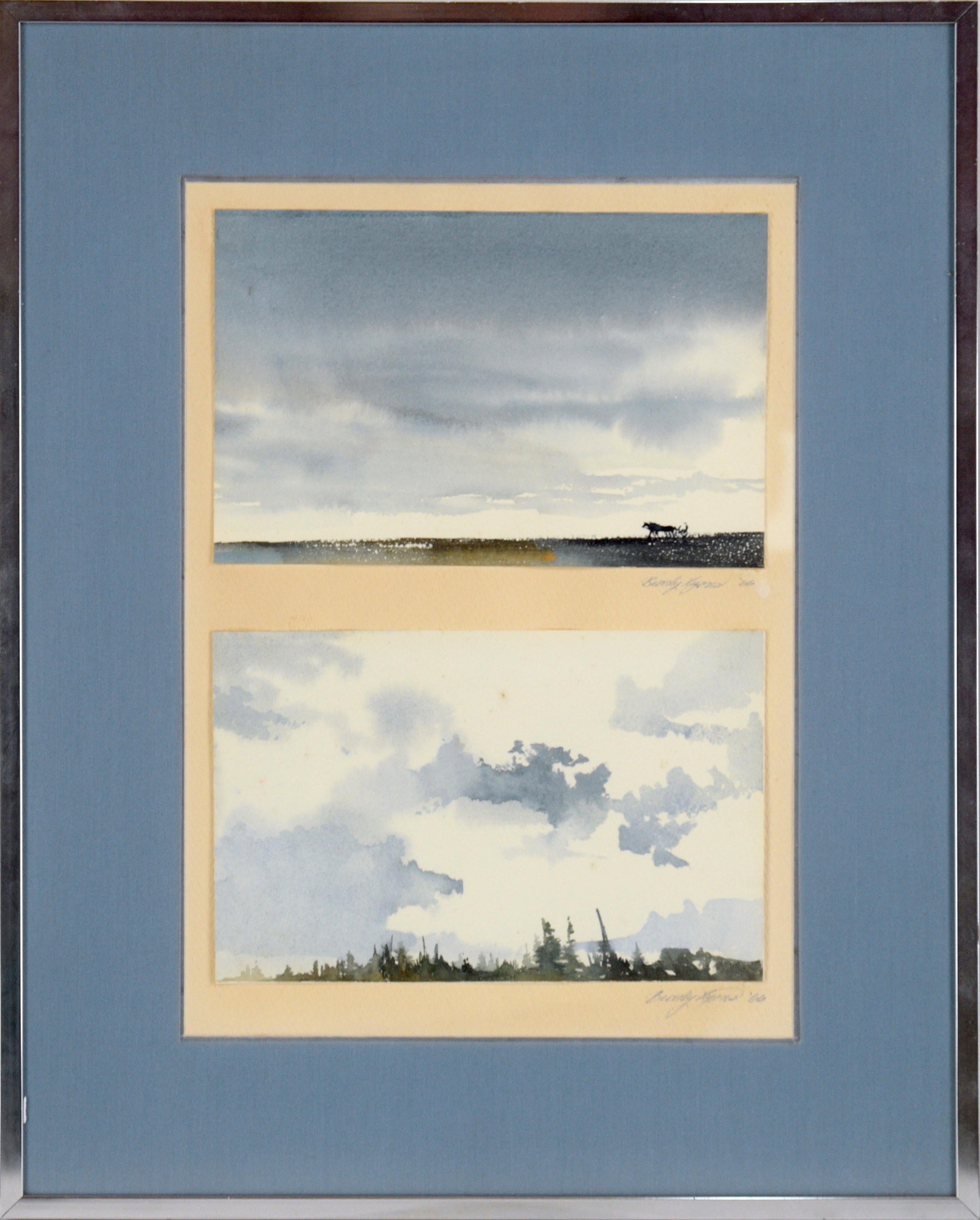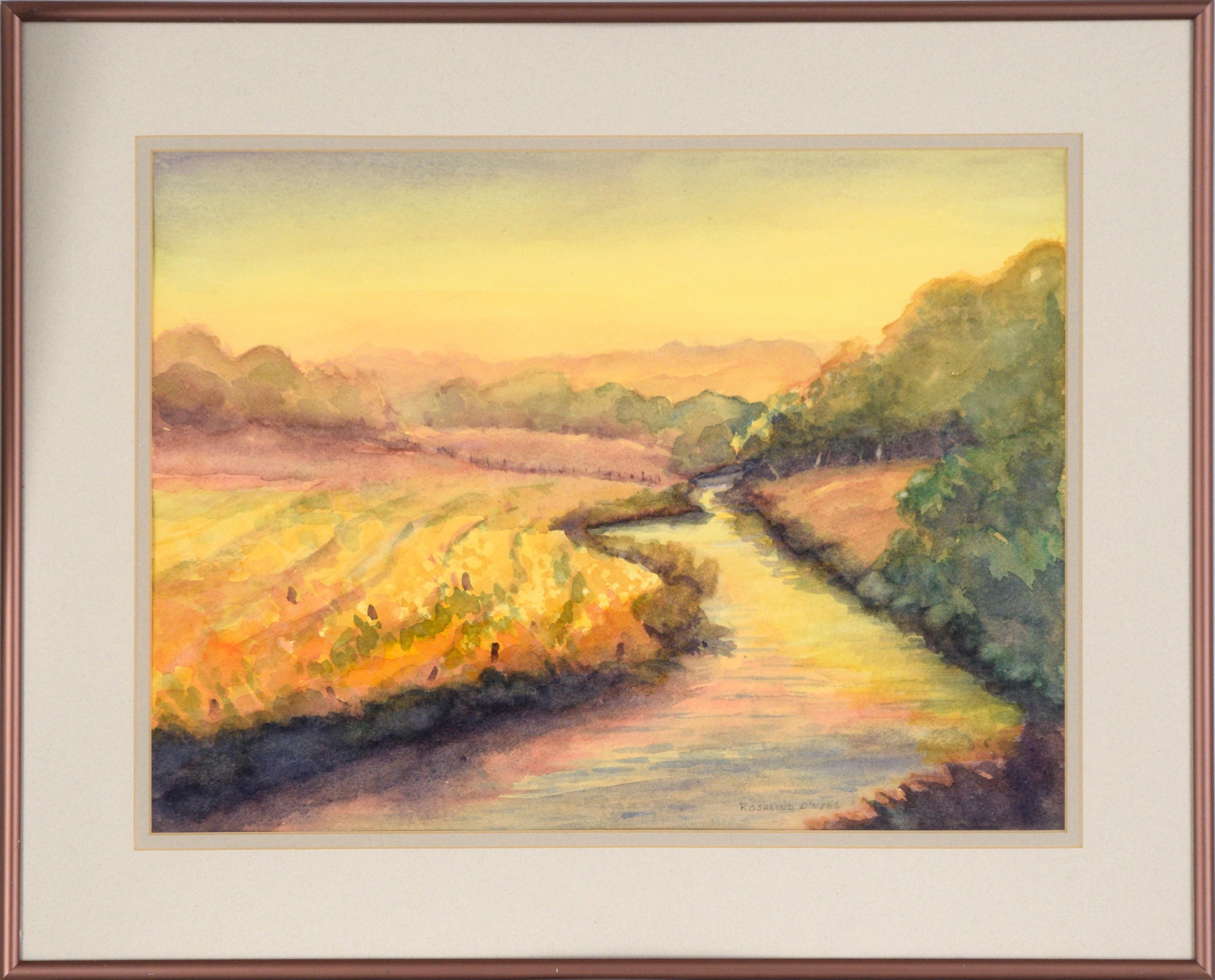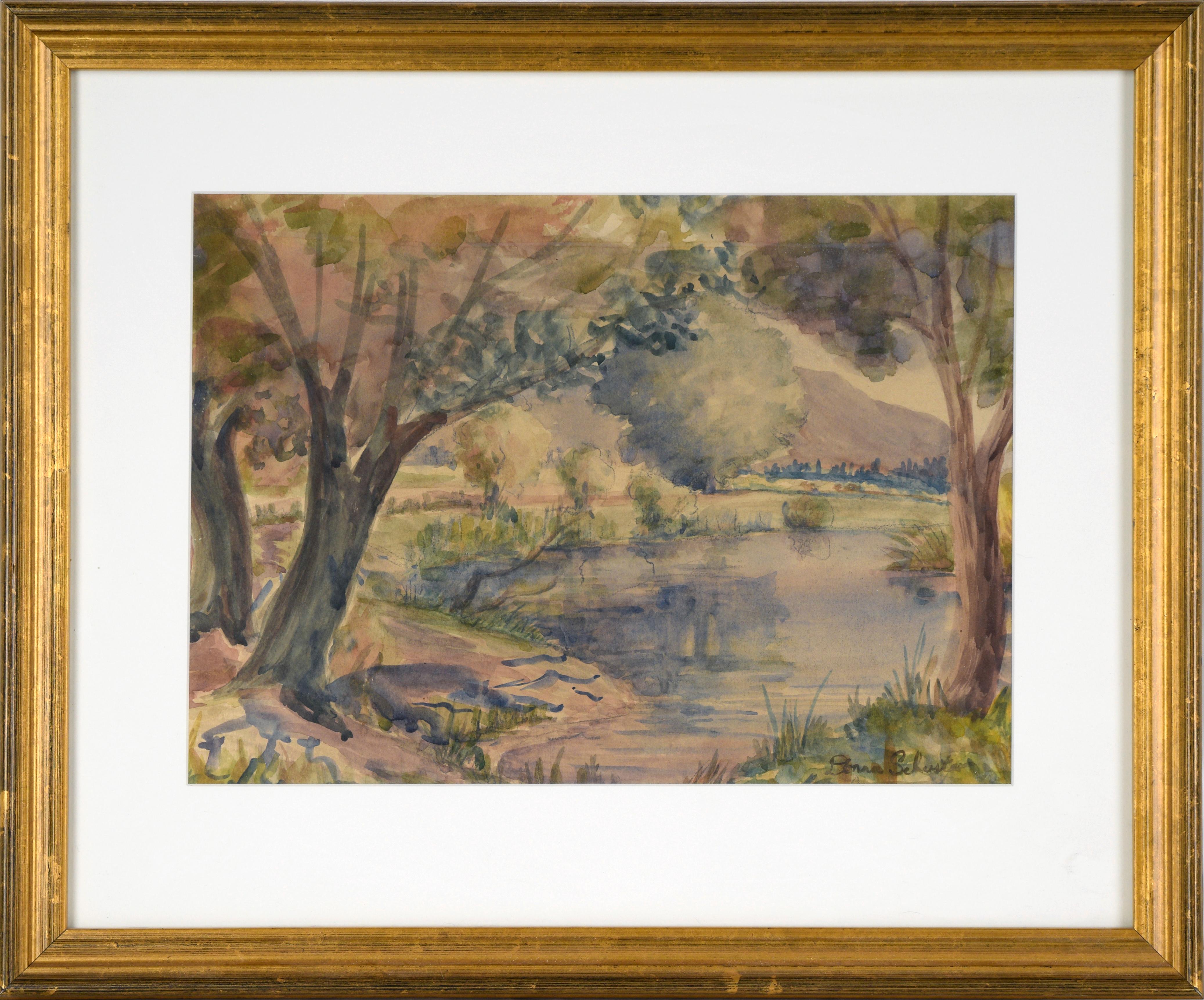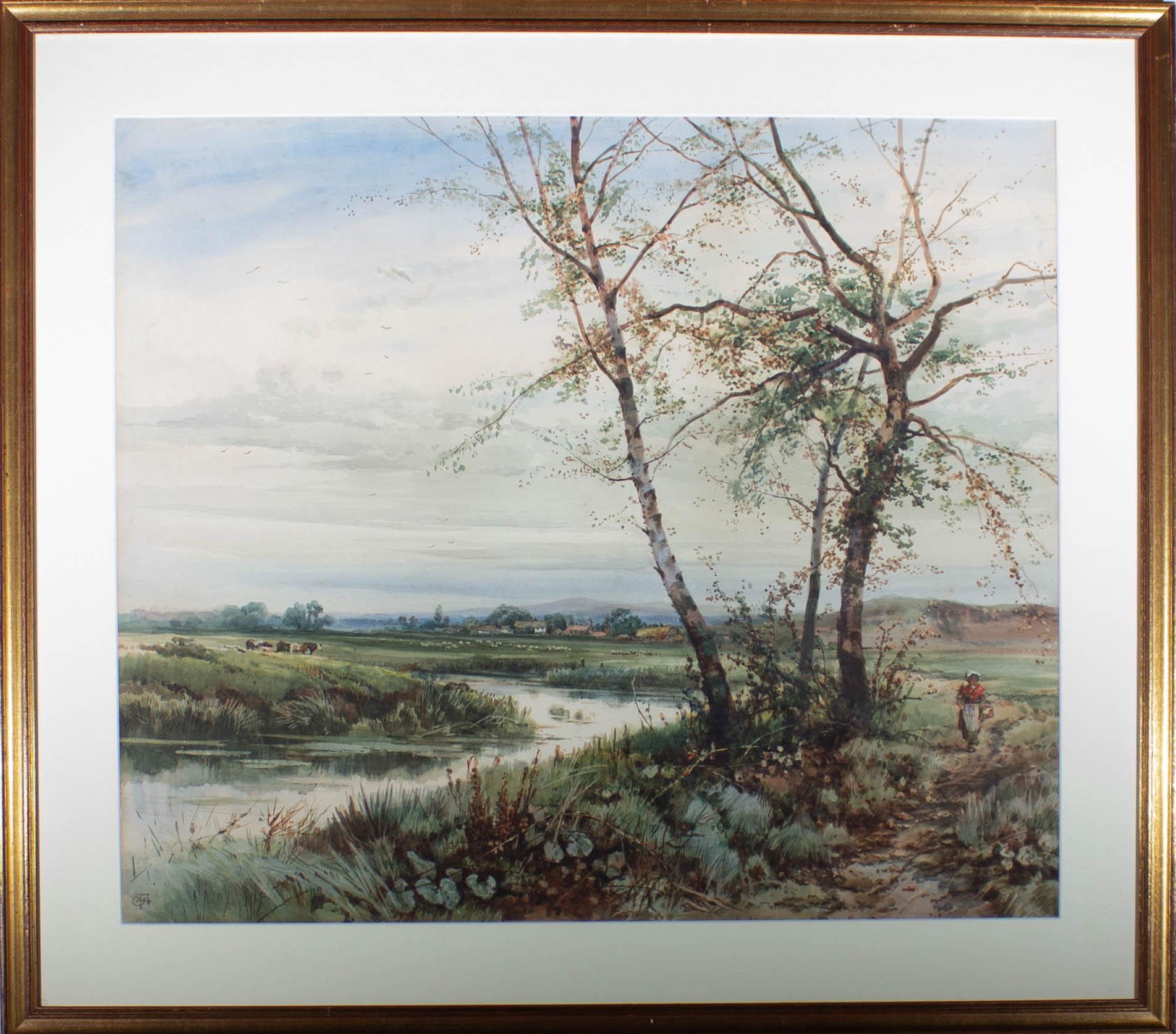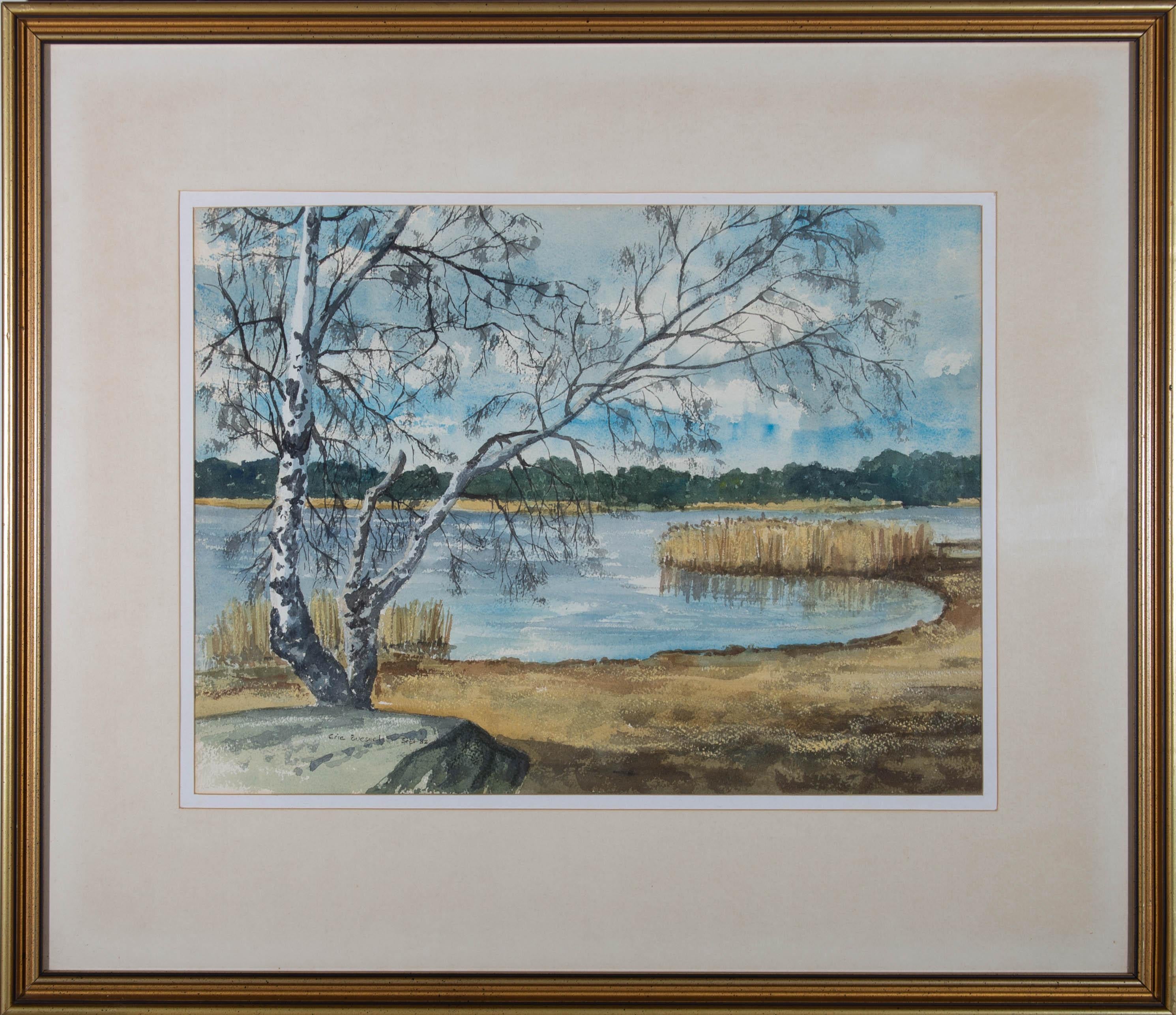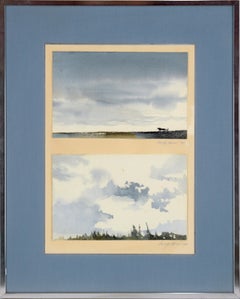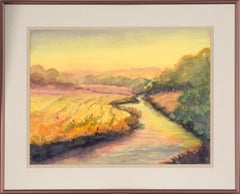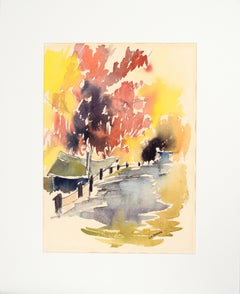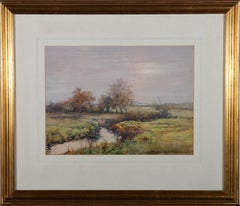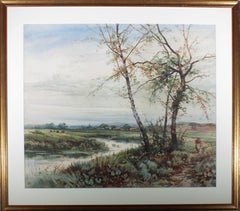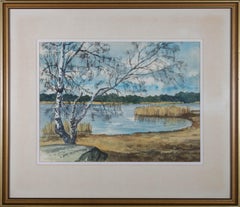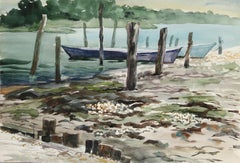Items Similar to Vintage Beyond The Waterline Watercolor on Paper
Want more images or videos?
Request additional images or videos from the seller
1 of 13
Mari GiddingsVintage Beyond The Waterline Watercolor on Paper1990s
1990s
$780
$97520% Off
£599.01
£748.7620% Off
€686.45
€858.0720% Off
CA$1,098.05
CA$1,372.5620% Off
A$1,230.06
A$1,537.5720% Off
CHF 639.78
CHF 799.7320% Off
MX$15,004.14
MX$18,755.1820% Off
NOK 8,145.27
NOK 10,181.5920% Off
SEK 7,680.41
SEK 9,600.5220% Off
DKK 5,123.50
DKK 6,404.3820% Off
About the Item
Beyond The Waterline by Mari Elsa Giddings (American, b. 1959)
Gorgeous vintage monotype original watercolor painting of a serene lake surrounded by vibrant trees of green. The lake sits quiet, with shadows from the trees glistening over it. There are patches of golden grass along the lakeside, and skies of blue sparkling against the water.
Signed lower right "Mari Elsa Giddings" and "Giddings" on verso.
Presented in a white mat.
Matted: 40"H x 32"W
Image: 26"H x 24"W.
Mari Elsa Giddings is a contemporary artist who was born in Washington, D.C. in 1959. She grew up in Maryland, New York, and then studied art at Phoenix College in Arizona with Meryl Mahaffey and Allen Dutton. She earned her Bachelor of Fine Arts degree at Arizona State University in 1984, where she worked under master printers, such as Dan Britten and Wayne Kimball.
In 1986 she became chief assistant to master printer Robert A. Devoe at the Phoenix Art Press. Shortly after, Mari opened her own studio in the Verde Valley in northern Arizona where she happily painted landscapes for several years. In 1991 Mari moved back to Phoenix to become the Art Director of Phoenix Art Press. n 1995 Mari co-founded the Planet Art Group in Phoenix, Arizona. Mari works in a variety of styles, from naturalistic landscapes to cubist abstraction, yet she sees no contradiction in these approaches.
Giddings says, "Neither strict representation nor abstraction is simply imitations of reality, but tools for the construction and reflection of an artist’s individual experience. As infants, we learn to objectify our individual perceptions through relating with others. In the same way, art allows us to conceptualize subjective experience by turning it into an object that can be shared. In this sense, all art, abstract and representational, is simultaneously self-portraiture and a mob scene, intimate and public."
- Creator:Mari Giddings (1959, American)
- Creation Year:1990s
- Dimensions:Height: 40 in (101.6 cm)Width: 32 in (81.28 cm)Depth: 1 in (2.54 cm)
- Medium:
- Movement & Style:
- Period:
- Condition:Good; Some ripples on paper and minor tear reinforced.
- Gallery Location:Soquel, CA
- Reference Number:Seller: N88551stDibs: LU54213295332
About the Seller
5.0
Platinum Seller
Premium sellers with a 4.7+ rating and 24-hour response times
Established in 1986
1stDibs seller since 2014
2,965 sales on 1stDibs
Typical response time: <1 hour
- ShippingRetrieving quote...Shipping from: Soquel, CA
- Return Policy
Authenticity Guarantee
In the unlikely event there’s an issue with an item’s authenticity, contact us within 1 year for a full refund. DetailsMoney-Back Guarantee
If your item is not as described, is damaged in transit, or does not arrive, contact us within 7 days for a full refund. Details24-Hour Cancellation
You have a 24-hour grace period in which to reconsider your purchase, with no questions asked.Vetted Professional Sellers
Our world-class sellers must adhere to strict standards for service and quality, maintaining the integrity of our listings.Price-Match Guarantee
If you find that a seller listed the same item for a lower price elsewhere, we’ll match it.Trusted Global Delivery
Our best-in-class carrier network provides specialized shipping options worldwide, including custom delivery.More From This Seller
View AllTwo Mid Century Rural Landscapes in Watercolor on Paper
Located in Soquel, CA
Two Mid Century Rural Landscapes in Watercolor on Paper
Two lovely watercolors by Beverly Lyons (American, 20th Century). In the top watercolor, an expansive sky sits above a strip ...
Category
1960s American Impressionist Landscape Drawings and Watercolors
Materials
Paper, Watercolor
Golden Hour at the River - Watercolor Landscape on Paper
Located in Soquel, CA
Golden Hour at the River - Watercolor Landscape on Paper
Glowing sunset landscape by Rosalind O'Neal (American, b. 1927). A river winds winds towards the viewer, reflecting the glowing sunset. On the left bank, there are rows of crops in yellow and orange. On the right side, trees and shrubs line the bank. In the distance green and golden hills meet the sky.
Signed "Rosalind O'Neal" in the lower right corner.
Presented in a copper colored frame with a double mat.
Frame size: 17"H x 21"W
Image size: 12"H x 16"W
Rosalind O’Neal (American, b. 1927) was a longtime Ukiah, CA resident and a member of the Mendocino County Art Association. O’Neal was primarily a watercolor artist, focusing on portraits and landscapes, but has also worked in acrylic at times.
1997 - Ukiah Main Office Savings Bank of Mendocino County, Ukiah, CA
2003 - Savings Bank of Mendocino, Ukiah, CA
2004 - Mendocino County Art Association’s Golden Anniversary...
Category
21st Century and Contemporary American Impressionist Landscape Drawings ...
Materials
Watercolor, Laid Paper
California Lake Landscape Original Watercolor on Paper
Located in Soquel, CA
California Lake Landscape in Watercolor on Paper
Serene landscape by Donna N. Schuster (American, 1883-1953). The viewer stands at the edge of a lake, under a few trees. At the far ...
Category
Early 20th Century American Modern Landscape Drawings and Watercolors
Materials
Watercolor, Laid Paper
An Enlightening Afternoon Near Oregonia - Watercolor Landscape on Paper
Located in Soquel, CA
An Enlightening Afternoon Near Oregonia - Watercolor Landscape on Paper
A cool pond and walking trail sprawl below an autumn canopy of trees in complementary reds and purples accent...
Category
21st Century and Contemporary American Impressionist Landscape Drawings ...
Materials
Paper, Watercolor, Charcoal
"Shenandoah Valley" - Rural California Landscape in Watercolor on Paper
Located in Soquel, CA
"Shenandoah Valley" - Rural California Landscape in Watercolor on Paper
Idyllic country landscape by California artist Alice M. Duke (American, 1921-2012). Two large brown-red barns sit at the edge of a glassy body of water. They are surrounded by towering dark green trees, which are reflected in the water along with the barns. Titled "Shenandoah Valley"; California Shenandoah Valley AVA is an American Viticultural Area that includes portions of Amador County and El Dorado County, California, United States. It is a sub-region of the Sierra Foothills.
titled "shenandoah Valley" and monogrammed AC #25 on mat verso verso.
(we have two others with signed labels "Alice Duke" and initialed AC #23 & AC #24 by this artist)
Presented in a vintage frame with a double mat.
Frame size: 16.75"H x 20.75"W
Image size: 10"H x 14"W
Duke, Alice (American, 1921-2012 was an artist from Jackson, California. She was a student of Dorner Schueler. A member and exhibitor with the Central Coast Art League.
Memberships:
Founding member, Gallery 10.
Central California Art League
Member, Northern California Arts.
Member, Society of Western Artist
Shows and Awards:
1999 - Gallery 10, Sutter Creek, CA
1986 - (1st Place, Watercolors) Sonoma Valley Art Center, Sonoma, CA
1985 - (Hon. Mention, Watercolors) Sonoma Valley Art Center, Sonoma, CA
1982 - Sunshine Art...
Category
1960s American Impressionist Landscape Drawings and Watercolors
Materials
Paper, Watercolor
Edge of the Lake Landscape
Located in Soquel, CA
Gorgeous landscape of the edge of a lake with mountains in the background by a California watercolor artist.. Signed in pencil in the lowe...
Category
1980s American Impressionist Landscape Drawings and Watercolors
Materials
Paper, Watercolor
You May Also Like
Norman M. Macdermot - Mid 20th Century Watercolour, Country Landscape
Located in Corsham, GB
An accomplished watercolour scene depicting a stream running through a country landscape. The artist has captured the scene in fine watercolour detail, highlighting the autumnal colo...
Category
Mid-20th Century Landscape Drawings and Watercolors
Materials
Watercolor
Early 20th Century Watercolour - Following The Meandering River
Located in Corsham, GB
A pretty pastoral scene in watercolour showing a river winding through meadows with grazing cows and sheep. A woman with a basket walks along the riverside path at the right. The art...
Category
20th Century Landscape Drawings and Watercolors
Materials
Watercolor
$695 Sale Price
20% Off
Eric Buesnel - 1982 Watercolour, Lakeside
Located in Corsham, GB
A tranquil scene depicting a birch tree before a lake. Signed and dated to the lower left. On wove.
Category
20th Century Landscape Drawings and Watercolors
Materials
Watercolor
$328 Sale Price
20% Off
River Side, Impressionist Watercolor by Eve Nethercott
By Eve Nethercott
Located in Long Island City, NY
Eve Nethercott, American (1925 - 2015) - River Side (57), Year: circa 1961, Medium: Watercolor, Size: 15 in. x 22 in. (38.1 cm x 55.88 cm), Description: Bobbing beside the moor...
Category
1960s Impressionist Landscape Drawings and Watercolors
Materials
Watercolor
New England Watercolor by American Artist George Howell Gay
By George Howell Gay
Located in New York, NY
George Howell Gay (American, 1858-1931)
Untitled Landscape, c. late 19th-early 20th century
Watercolor on board
12 x 17 3/4 in.
Framed: 16 1/4 x 22 1/4 in.
Signed lower right: Geo Howell Gay
George H. Gay was well known for his watercolor landscapes, seascapes and paintings of rivers and ships, mostly along the shores of New England. Gay also painted snowscapes, but these are scarcer. It is unusual to find an oil painting by this artist, as he worked mainly in watercolor. Some of his works display a tonalist aesthetic.
He was born in Milwaukee, Wisconsin on July 2, 1858, and lived in Chicago and then in 1889, settled in Bronxville, New York. Gay was a pupil of Paul Brown and Henry Elkins in Chicago.
He is known to have exhibited at the National Academy of Design in 1890; Boston Art...
Category
Early 20th Century American Realist Landscape Paintings
Materials
Watercolor, Board
Landscape - Watercolor by Alfonso Avanessian - 1990s
Located in Roma, IT
Landscape is an original watercolour on paper realized by Alfonso Avanessian in the 1990s.
The piece is hand signed lower right.
Good condition.
...
Category
1990s Modern Figurative Paintings
Materials
Watercolor
More Ways To Browse
Phoenix Art Group
Used Kimball
Devoe Painting
H C Kimball
Mari Giddings
French Ocean Paintings
Mining Paintings
Midcentury Paris Street Painting
19 Century American Portraits
Moody Landscape Oil
Brooklyn Bridge Painting
Bucolic Painting
Cabin Painting
Oil Painting Of Sheep
Woman In The Waves
Alpine Landscapes
Artist Marin
Benezit Painting
